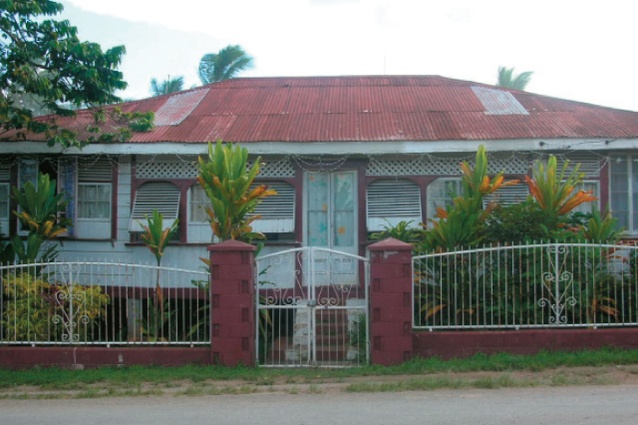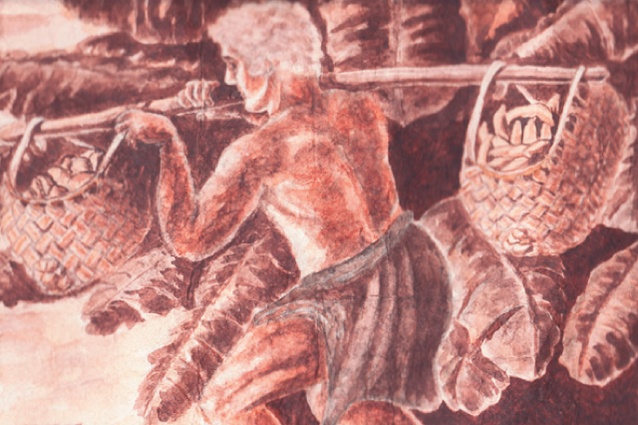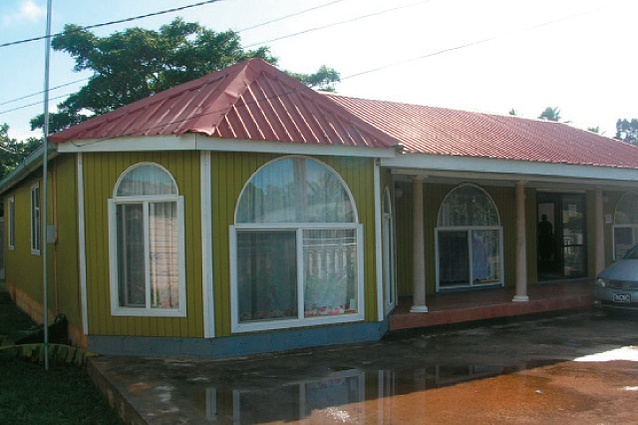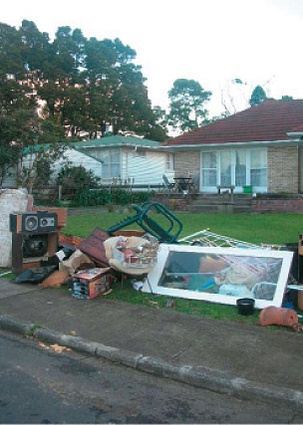Building Tonga’s Western fale
The Tongan diaspora around the Pacific Rim – particularly in Auckland – participate in a rich history of architectural exchange, sending discarded building materials home for use in dwellings.
The va where it began
In an account told to Peter Dillon by John Singleton, one of the survivors of the British vessel Port-au Prince, he describes an early va, or engagement, between Tongan islanders and some of its first Palagi, or Europeans:
“The chiefs of these islands [he said] pride themselves much on having Europeans resident among them; a feeling that gave rise to the following unfortunate affray:– The morning on which the ship [Astrolabe] was about to sail, two of the crew, unperceived by the sentinels, had leaped from the side into a large canoe, where they were concealed by the natives. The canoe immediately pulled for the shore … The chief of this canoe having acquainted those on shore that he had two Europeans with him, the other chiefs became jealous, and said, ‘we must have some white men to live with us as well as you.’ ”
Why did the early Tongans want Palagi to reside with them? One possible motive is ’inasi, a sacred “first fruits” ceremony where Tongan people presented “an offering … the first products of the land, as well as other edibles such as fish, to all the gods through the person of the divine chief Tu’i Tonga.” Men and women would present their best gifts, or ’inasi, in woven coconut leaf baskets. Men most often presented food crops, including yams, and puaka toho, or a large overfed pig, and women gave their koloa, consisting of ngatu (bark cloth) and fala (woven mats). Tongans only present what they consider to be their finest possible gifts, thus proving their respect for the Tu’i Tonga and also showing themselves to be, as anthropologist Ping-Ann Addo says, “good Tongan” men and women. ’Inasi as a practice is about literally and metaphorically giving one’s “best” to honour or advance Tonga, nationally and locally, in return, elevating one’s status in society.
The covetous remarks of the Tongan chiefs, in Singleton’s account, show the esteemed value of early Palagi – not only as an exotic person but, as an addition to a household, the Palagi becomes a human resource to fulfil ’inasi. It became common practice to take in a Palagi, such as William Mariner, a survivor from the British vessel Port au Prince, who was invited to live with one of Tonga’s high chiefs, which he did for a couple of years and was regarded as the chief’s “son.” This first va between Tonga’s first Palagi and early Tongans began a pattern of Tongan interest in the West – and this has fuelled the appropriation of Western architecture for Tongan domestic dwellings.
In response to colonial theory, the process of ’inasi insists that Tongans were not merely passive agents during Western imperialism in the Pacific. Unlike its neighbours, the Tongan islands were never colonised. Since the West was not a direct imperial threat, Tongans employed Western-styled domestic fale (dwellings) more receptively than, for example, nearby Samoa which had experienced direct imperial contest and thus appropriated Western building practices and materials more slowly, as discussed by Albert Refiti. Rather than being a model of colonial resistance, Tonga’s process of ’inasi sees Tongans selectively appropriate from another culture what they consider valuable to fulfil their objectives. What they select depends on subjective preferences – in retrospect, generally Western styles of building and design. For example, the late-nineteenth-century fale ‘ae Palagi (discussed below) reveal the timber villa and cottage styles considered valuable building types at the time. The “slippage” – inevitable in this appropriation process – becomes “Tonganness,” recognising the autonomy of Tongan agency and how they adapt the Western model to suit their local and specific needs.
Fale ’ae Palagi
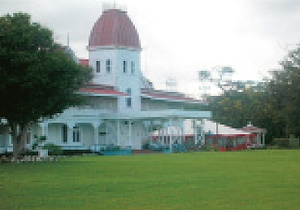 The naissance of Western-style dwellings and the wide spread of Western building practice in early-nineteenth-century Tonga thrived on two agenda with complementary outcomes. The first wave of missionaries arriving in 1797 were tradesmen – bricklayers, carpenters and joiners – eager to teach Tongans construction skills to gain their trust before attempting any conversion.
The naissance of Western-style dwellings and the wide spread of Western building practice in early-nineteenth-century Tonga thrived on two agenda with complementary outcomes. The first wave of missionaries arriving in 1797 were tradesmen – bricklayers, carpenters and joiners – eager to teach Tongans construction skills to gain their trust before attempting any conversion.
In response, Tongans were eager to learn the new building practice of the Palagi for ’inasi, so they could construct for themselves more tolonga, or longer lasting, homes. These new materials and building practices replaced the natural materials of their fale Tonga, which required more frequent repair. The agenda of the imperialist and indigenous objectives were complementary – the reason why Western architecture has thrived in Tonga.
With the assistance of Shirley Baker, an influential missionary and premier of Tonga, Tonga’s first monarch, King George Tupou I, instituted Western models as Nuku’alofa’s waterfront civic architecture to support this political agenda of ’inasi. This architectural staging included the fale Palace, erected in 1867 as a Victorian-style, two-storeyed timber building with large verandahs and architectural elements referencing international trends, such as its lofty tower. King George’s architectural ambition and taste for Western architecture must have inspired Tongan people, if not politically then surely architecturally. He gathered a following of Tongan aristocrats and affluent individuals, who also built or imported prefabricated kitsets – including Victorian elements and simple wooden cottage parts – and assembled them as private residences.
The strong commercial and trade links between New Zealand and Tonga from 1901 meant the country’s housing development became a popular source of prefabricated Victorian elements for buildings. By the 1880s, timber company catalogues advertised these different architectural elements, which made the items more accessible to people overseas, particularly Tongans and Palagi in Tonga. Although many of the Western-styled structures in Tonga were constructed after 1860 – coinciding with the New Zealand Victorian villa’s height of popularity – the fale ’ae Palagi have more in common architecturally with the simple New Zealand colonial dwellings built before 1860. Most likely, it was economical to source and export this more “dated” and simpler prefabricated kitset. Conservation architect Jeremy Salmond explains that before 1860 the New Zealand “wooden cottage of one or two rooms, with a central door and a window either side of the door, remained the basic unit” from which the rest of the colonial houses of the nineteenth century developed. The fale ’ae Palagi are essentially a simple white cottage, seen in the now urban villages like Kolomotu’a.
The fale ’ae Palagi became a desirable house to appropriate. Once inherited or acquired, Tongans have attempted to preserve the fale ’ae Palagi’s fakapapalagi, or Europeaness, by only adding minimal architectural interventions where necessary for climatic comfort or cultural living. Importantly, the exteriors of almost all fale ’ae Palagi have continued to be painted white, reinforcing the archetype’s Western associations. To borrow architectural historian Sarah Treadwell’s thoughts regarding missionary houses in Rarotonga, retaining the white exterior is a demonstration of virtue, in reference to architectural theorist Mark Wigley’s argument that “[t]he whole moral, ethical, functional and technical superiority of architecture is seen to hang on the whiteness of its surface.”11 Certainly, the whiteness of Tonga’s colonial cottage appealed to the Tongan family giving them a surface of distinction; it is common to find these fale ’ae Palagi still “hung” on their whiteness. In alignment with the ’inasi practice, altering the integrity of the fale ’ae Palagi was, and continues to be, avoided.
Fale Tufitufi

The fale Tufitufi emerged in the mid 1990s, as a model built from discarded materials, predominantly from Auckland’s demolition yards and suburban inorganic dump. Sometimes, the building materials are also sent over by relatives from other Pacific Rim cities like San Francisco or Honolulu. The va, in this case, is between Tongans in the international diaspora. Today, as Tongans disperse internationally, they engage in new experiences and develop new ideas. After such experiences, many return to Tonga with a fresh perspective on building, and can “give back” architecturally through remittance and importation, fulfilling ’inasi.
In Tonga, people who produce the fale Tufitufi are considered part of an emerging middle class because they have connections abroad and the economic capacity to obtain imported Western materials. Thus, the va between the home owners and the source of building materials – in this case, demolition yards, suppliers, and diasporic Tongan communities abroad – is an important factor in the creation of fale Tufitufi. Tongans in the South Pacific prefer to find their materials in Auckland since it is more cost effective to ship from New Zealand than Australia or North America. Sometimes, Tongans abroad are given leftover materials by their employers for free or at a discounted price. They are usually builders or yardmen working in the building industry. It is common to hear that a family has received leftover materials from a wealthy American family who employ Tongan relatives for yard work.
The second important source of materials, especially for Tongans living in New Zealand, is the inorganic rubbish disposed of by suburban families in annual street collections. Tongans call this tufi veve, which means “collecting rubbish.” In the early 1990s, this was a popular activity among lower socio-economic Auckland-based Pacific Islanders. Groups of collectors, usually family members of all ages, would drive around affluent suburbs like Remuera, Howick and Takapuna and hunt for reusable building materials and household furniture. As a result, many Tongans have constructed and fitted-out their Auckland sleep-outs and garages from this material. In this way, the fale Tufitufi encourages the sustainable practice of mo’ui lavame’a, or resourcefulness, observed in this process of recovering disposed building materials from Western countries and importing them back to Tonga for the construction of fale Tufitufi.
According to the modern practice of ’inasi, Western materials in general are associated with modernity, affluence and durability. As in earlier times, the use of Western materials or models showed that a family has links to other resources. The same thinking persists: as families scavenge for materials, they look for building materials with strong suggestions of Western origin, such as classical columns, aluminium window frames and steel roofing. In such cases, more value is placed on items that look modern than on the function of the materials. For example, people prefer sealed windows to louvres despite the obvious passive ventilation benefits provided by the latter.
Builders and owners try to recreate the suburban home for the village condition – however, by building with reclaimed materials and often in an improvised design and build process, this architectural translation becomes an eclectic building type. Furthermore, the model develops a distinct “Tonganness” when the Tongan owner must negotiate ‘inasi aspirations; family and cultural requirements and what materials are actually available.
Conclusion
‘Inasi applied to Tongan architecture gives a new understanding of the country’s Western-style housing stock. Just as those first imperialists had an agenda for Tonga, Tongans had their own motivations for why and how they engaged Western culture and, in particular, its architecture. This particular va, or cultural crossroad, was favourable for both parties since each wanted something that the other provided.
During an enlightening conversation with two influential Tongan architects based in Nuku’alofa – specialists expected to know such architectural distinctions – they described the Western-style fale ’ae Palagi as “Tongan architecture,” implying perhaps the general Tongan consensus, that there is no longer a clear distinction between Western- and indigenous-derived building types in Tonga – indeed the total appropriation of the Western-style fale into Tongan culture. In other words: ’inasi accomplished.
- Peter Dillon, Narrative and Successful Result of a Voyage in the South Seas … to Ascertain the Actual Fate of La Perouse’s Expedition… 2 vols. Facsimile reprint, Bibliotheca Australiana, No. 53. (Amsterdam: N. Israel, 1972 [1829]), I: 267.
- Elizabeth Bott, Tongan Society at the time of Captain Cook’s Visits: Discussions with Her Majesty Queen Salote Tupou (Wellington: Polynesian Society, 1982), 92.
- Ping-Ann Addo, “Kinship Cloth and Community in Auckland, New Zealand: Commoner Tongan Women Navigate Transnational Identity using Traditionally-Styled Textile Wealth,” PhD dissertation, Yale University, New Haven, 2004, iv.
- William Mariner, An Account of the Natives of the Tonga Islands … with a Grammar and Vocabulary of Their Language… Compiled by John Martin, 2 vols. 3rd ed. (Edinburgh: Constable and Co., 1827).
- Pers. comm. Albert Refiti, Samoan architectural theorist; Talanoa discussion in Auckland; 16 April 2009.
- Helen Boutell and Ian Campbell, Tukulaumea: The Long Civil Wars, Book 3 (Kingdom of Tonga: Taulua Press, 1992), 9.
- Nelson Eustus, Tonga Sketchbook (Adelaide: Hype Park Press, 2002), 38.
- John Bernard Prendergast, “Trade, External,” in A. H. McLintock (ed.), Encyclopaedia of New Zealand (1966), on Te Ara – The Encyclopedia of New Zealand, accessed 28 August 2007. http://www.TeAra.govt.nz/1966/T/TradeExternal/en
- Di Stewart, The New Zealand Villa: Past and Present (Auckland: Penguin Books, 1992), 23.
- Jeremy Salmond, Old New Zealand Houses: 1800–1940 (Auckland: Reed Methuen Publishers Ltd, 1986), 73.
- Sarah Treadwell, ‘Dazzling Reflections: Images of Architecture in Missionary Polynesia’, Pacific Colloquium, Victoria University of Wellington, 15 September 2007.

